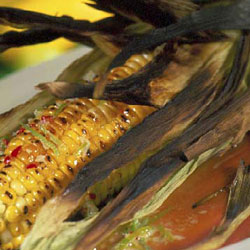Corn talk


Corn Talk
Traditional advice, to put the water on to boil before going down to the corn patch to pick the corn, has plenty of merit. As soon as the sweet corn is cut from the plant, the sugar starts turning to starch, so the sooner you get it in the pot, the sweeter it’s going to be. New varieties of corn retain the sugar longer before it converts to starch, but speed is still essential; no amount of care and gentle massaging is going to resurrect withered corn cobs. The other old wives’ tale is true too; don’t salt the water until the corn is cooked, or salt it at the table, because if added during cooking it toughens the kernels.
If you want to check the degree of ripeness on growing corn, open a cob and prick the kernels. If the juice is clear, the cob is not yet ready to pick. If the juices are milky, don’t hesitate – go back and put the water on to boil. If there is no liquid the corn is past its best. Once picked, keep the corn in its husks, put in a plastic bag and refrigerate. Remove the husks just prior to cooking.
Corn is a high carbo food, with good quantities of Vitamin A, B and C. It contains potassium and moderate amounts of protein, and hardly any fat.
Plunge cobs into a large saucepan of gently boiling water (cook in unsalted water; cooking corn cobs in salted water can toughen the kernels). Cook very fresh cobs with small kernels for 5-10 minutes, but more mature cobs, or those that have been picked for a few days, for 15 minutes. Drain and serve hot. If serving cold, or using as an ingredient in a recipe, cool the cobs, wrapping each cob in a piece of paper towel. This will prevent the kernels from drying and wrinkling. Once the cobs are cool use a large sharp knife to slice off the kernels. Corn prepared this way can be added to salads (toss very gently if you want to keep the kernels together in strips), or gently warmed in a microwave, first tossed with butter, herbs or spices (ground ginger and cumin are both good), or briefly pan-fried with butter, garlic, chilli and spices until piping hot – although the kernels will separate – or cooked until golden brown.
Corn cooked on the barbecue is sweet, nutty and juicy. The corn needs to be soaked in cold water first, then it can be put directly on the grill, or cooked on the hot plate on a hooded barbecue and cooked with the lid down. As the corn cooks the water gently steams the corn and the natural sugars caramelize. Gorgeous!
Gardening tip
Along with green beans, corn and zucchini (or other members of the squash family), form the trinity known as ‘The Three Sisters’ in southern American gardening lore. When beans and corn are grown together, the beans draw nitrogen from the soil, which the corn thrives on. Squash and pumpkin, with their prickly vines, are planted around the beans and corn to stop pesky wild animals destroying the plants. It’s a combination you might like to try in your own garden.
Recipes
Sweet corn, Tomato and Avocado Salad
Fresh Sweet Corn Fritters